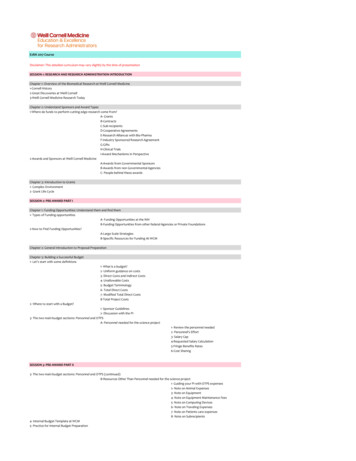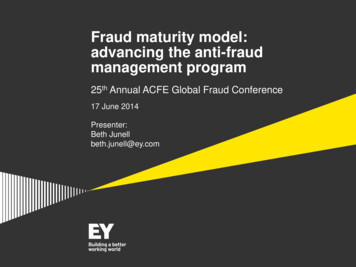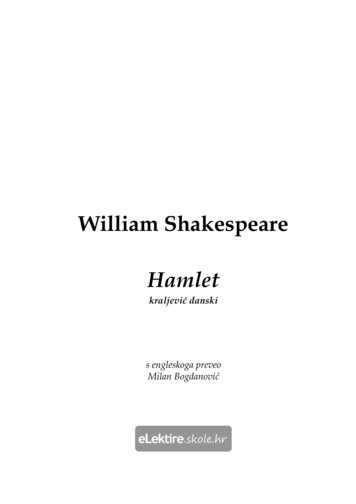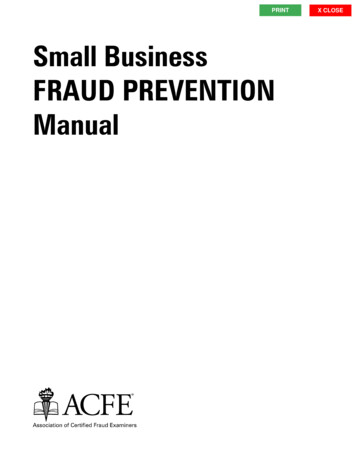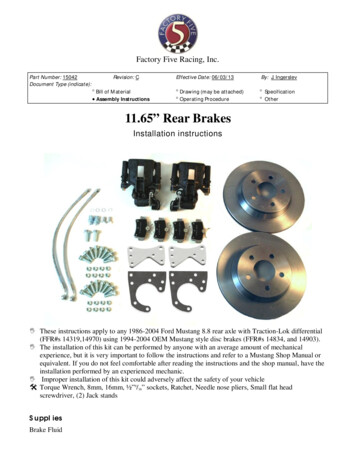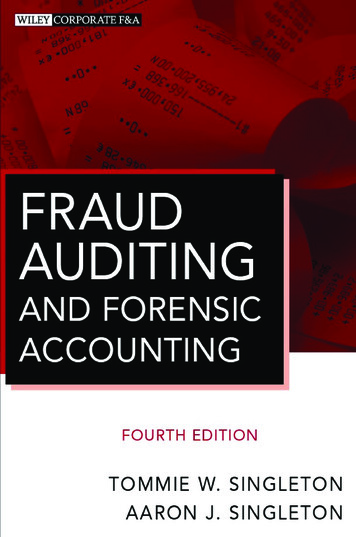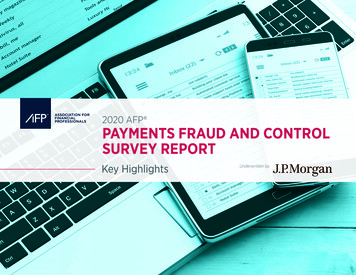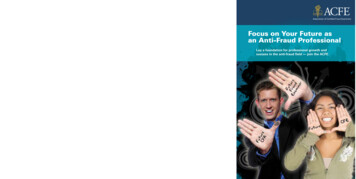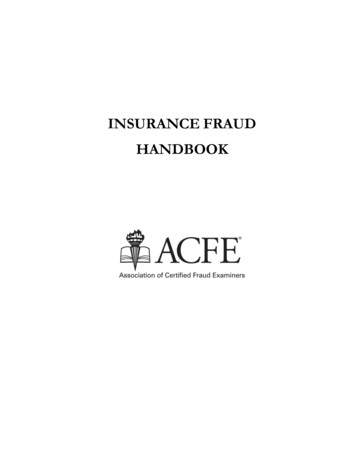
Transcription
INSURANCE FRAUDHANDBOOK
2018 by the Association of Certified Fraud Examiners, Inc.“Association of Certified Fraud Examiners,” “Certified Fraud Examiner,” “CFE,” “ACFE,” “CFEExam Prep Course,” “Fraud Magazine,” “Report to the Nations,” the ACFE Seal, the ACFE Logoand related trademarks, names and logos are the property of the Association of Certified FraudExaminers, Inc., and are registered and/or used in the U.S. and countries around the world.COURSE REVISION DATE: 12/22/18No portion of this book may be reproduced or transmitted in any form or by any means electronicor mechanical, including photocopying, recording, or by any information storage and retrievalsystem without the written permission of the Association of Certified Fraud Examiners, Inc.The Gregor Building716 West AvenueAustin, Texas 78701 USA(800) 245-3321 1 (512) 478-9000ACFE.comDISCLAIMERS:Every effort has been made to ensure that the contents of this publication are accurate and freefrom error. However, it is possible that errors exist, both typographical and in content. Therefore,the information provided herein should be used only as a guide and not as the only source ofreference.The author, advisors, and publishers caution that this publication is not meant to provide legaladvice. The user should always consult with an attorney regarding the specific rules and regulationsfor your state or locality.Printed in the United States of America.
INSURANCE FRAUD HANDBOOKTABLE OF CONTENTSI. INSURANCE FRAUD OVERVIEWIntroduction to Insurance Fraud . 1Insurance Fraud Schemes . 2Red Flags of Insurance Fraud . 8Summary. 11II. ESTABLISHING AND MEASURING A NEW SPECIAL INVESTIGATION UNITIntroduction . 13Measurement Systems in Place . 15Who Measures? . 15How Often Are Measurements Taken? . 16Calculating Savings . 16Factors in Measuring Performance . 18Additional Rating Factors . 18Expensing SIU Costs . 19Areas of SIU Responsibility . 19SIU Personnel Selection. 20Technology Requirements . 22Data Mining and Link Analysis. 24Integrated Business Processes . 25Anti-Fraud Personnel . 26Summary. 26III. THE POLICY: THE CONTRACTKnowing the Policy and Its Language . 31The Policy as a Contract . 32First- and Third-Party Policies . 34Innocent Coinsured . 35Mortgages and Loss Payees . 37IV. CONDUCTING THE EXAMINATION UNDER OATHEffective Use of the Examination Under Oath . 44The Uses of an Examination Under Oath . 46Insurance Fraud Handbooki
INSURANCE FRAUD HANDBOOKIV. CONDUCTING THE EXAMINATION UNDER OATH (CONT.)The Interplay of the Arson and Fraud Defenses in a Fire Claim . 51Summary. 54V. THE INSURANCE INTERVIEW PROCESSThe Preliminary Statement of the Insured or Claimant . 57Statement Methods . 59Witness Statements . 66VI. INFORMATION GATHERING AND LEGAL ISSUES OF SHARINGImmunity Reporting Acts . 71Public Records Laws . 76Reciprocal Information Exchange . 78Disclosure . 78Ethics and Insurance Fraud . 82Information Gathering . 82Domain Name Searching. 86Historical Website Information . 86Secretary of State Records . 86City and County Business Licensing . 87Newspaper Searches . 87Professional Licensing . 87UCC Filings . 87Treat All Information Obtained as a Lead . 87Summary. 88VII. CONDUCTING SURVEILLANCEMethods of Surveillance. 90Preparation . 90Techniques of Foot Surveillance . 91Techniques of Vehicle Surveillance. 92Fixed Surveillance . 93Satellite Surveillance. 94Night Surveillance Equipment . 94Vendor Management . 95Summary. 100iiInsurance Fraud Handbook
INSURANCE FRAUD HANDBOOKVIII. EXPERT SELECTION PROCESSSelection Process Steps . 101Fire and Explosions . 104From Theory to the Courtroom . 106Spoliation—NFPA 921—Daubert—Systematic Approach . 108Validation of Expert Opinions . 112Scientific Testing: What Can a Laboratory Contribute to the Case?. 114Summary. 115Insurance Fraud Handbookiii
INSURANCE FRAUD HANDBOOKABOUT THE AUTHORJAMES E. WHITAKER, CFE, CPP, PCI, CIFIPresidentThe Whitaker Group, LLCJames E. Whitaker is president and founder of the Whitaker Group, LLC, an investigative services andrisk management consultant group headquartered in Ohio. As a retired police detective divisioncommander; FBI National Academy graduate; Special Investigations Unit (SIU) director and later aclaims executive for a property and casualty insurance carrier; and executive director for theInternational Association of Arson Investigators, he has dealt extensively with insurance fraud in itsmany forms since 1971. He has a bachelor’s degree in criminal justice administration and a master’sdegree in management (with an emphasis on organizational design), both attained from MyersUniversity in Cleveland, Ohio.Mr. Whitaker has been a CFE since 1993 and is a Regent Emeritus as well as an adjunct faculty memberfor the ACFE. He has been a guest lecturer at ACFE Annual Conferences as well as ACFE Chapters inCincinnati, Columbus, Cleveland, Pittsburgh, Philadelphia, Baltimore, and New Orleans.Mr. Whitaker is a Certified Insurance Fraud Investigator and serves on both the Investigation andInsurance Fraud Councils (co-chair) for ASIS International. He also serves as an adjunct faculty memberfor ASIS on the PCI (Professional Certified Investigator) review course faculty. Mr. Whitaker is afrequent lecturer on the topic of insurance fraud across the United States and serves as a consultant tovarious insurance companies on fraud related issues, employee training, and ethics programdevelopment.Insurance Fraud Handbookv
Insurance Fraud OverviewI. INSURANCE FRAUD OVERVIEWIntroduction to Insurance FraudAside from tax fraud, insurance fraud is the most practiced fraud in the world. The insurance business,by its very nature, is susceptible to fraud. Insurance is a risk distribution system that requires theaccumulation of liquid assets in the form of reserve funds that are, in turn, available to pay loss claims.Insurance companies generate a large, steady flow of cash through insurance premiums. Steady cashflow is an important economic resource that is attractive and easily diverted. Large accumulations ofliquid assets make insurance companies attractive for take over and loot schemes. Insurance companies areunder great pressure to maximize the return on investing the reserve funds, thus making themvulnerable to high yielding investment schemes.What Is Insurance Fraud?To conquer insurance fraud, one must first know what insurance is. In basic terms, it is a contractbetween an insurer and an insured. In a contract, the insurer indemnifies the insured against losses,damages, or liability from an unknown event. A preexisting condition must not exist for insurance to bevalid. For example, obtaining automobile insurance after an accident is not insurance and does notindemnify the insured for any injuries suffered. Insurance fraud exists when individuals attempt to profitby failing to comply with the terms of the insurance agreement. Perpetrators of insurance fraud try tocreate losses or damage rather than joining others who have no losses but wish to keep themselvesprotected in case an unknown event should occur. Fraud can occur at any stage of an insurancetransaction by any of the following: Individuals applying for insurance Policyholders Third-party claimants Professionals who provide services to claimantsInsurance fraud can come in two forms: (1) hard frauds and (2) soft frauds. A hard fraud occurs whenan accident, injury, or theft is contrived or premeditated to obtain money from insurance companies.When a legitimate loss occurs, such as theft of a cell phone, and the insured adds an item to the claim(e.g., a phone accessory) to cover the deductible, it is considered a soft fraud. Soft fraud occurs when alegitimate claim is exaggerated.Impact of Insurance FraudThe cost of insurance to consumers continues to grow each year due to the huge losses that occurwithin the insurance industry. Most carriers can only estimate what they lose to claims that arediscovered to be fraudulent. Insurance fraud usually does not come to light until the fraudsters getgreedy and it becomes apparent that they are involved in an insurance fraud scheme.Insurance Fraud Handbook1
Insurance Fraud OverviewInsurance fraud is not limited to one group, race, or gender. It is an equal opportunity crime that can beperformed by an insurer or an insured. Insurance fraudsters are less likely to be turned over to theauthorities because they are usually not equipped to handle or perform an adequate investigation due tolack of expertise in insurance. For insurance fraud to be proactively addressed, insurers must train theirstaff in identifying the red flags of insurance fraud schemes.Insurance Fraud SchemesThere are numerous types of insurance fraud schemes. This section introduces some of the mostcommon types of fraud involving the insurance industry: Agent and broker schemes Underwriting irregularities Vehicle insurance schemes Property schemes Life insurance schemes Liability schemes Health insurance schemes Worker’s compensation schemesAgent and Broker FraudCASH, LOAN, AND DIVIDEND CHECKSA company employee without the knowledge of an insured or contract holder requests cash, a loan, or adividend check, and deposits the check into either their bank account or a fictitious account. Tominimize their chances of being detected committing a fraudulent act, the employee might change thecompany policyholder’s address of record to either their address or a fictitious address. Once the checkis issued, the address is then changed back to the previous address.SETTLEMENT CHECKSA company employee can misdirect settlement checks, such as for a matured endowment settlement, tothe branch office, the employee’s home, or a fictitious address. The employee can easily create a checkdefalcation by changing the address of record prior to the settlement check issue date, thus misdirectingthe check in question. Also, an orphan contract holder might be transferred to the employee’s agencyperiodically, affording the opportunity to improperly request the issuance of a settlement check.An orphan contract holder is a policyholder or contract holder who has not been assigned to a servicingagent or the whereabouts of this individual is unknown. The servicing agent attempts to locate thisfamily group and could influence them to purchase additional insurance.2Insurance Fraud Handbook
Insurance Fraud OverviewPREMIUM FRAUDThe agent collects the premium, but doesn’t remit the check to the insurance company. The insured hasno coverage.FICTITIOUS PAYEESAn agent or a clerk can change the beneficiary of record to a fictitious person and subsequently submitthe necessary papers to authorize the issuance of a check.FICTITIOUS DEATH CLAIMSAn agent or employee obtains a fictitious death certificate and requests that a death claim check beissued. The agent receives the check and cashes it.The sales representative can also write a fictitious application and, after the contestable period (e.g., twoyears), submit a phony death claim form and obtain the proceeds. The agent, by investing a fewthousand dollars, could receive 50,000 or more in misappropriated claims.Underwriting IrregularitiesEQUITY FUNDINGEquity funding is the process of using existing premium/policy values to finance new businesses. Solong as the insured is aware of what is being done by the agent and fully understands the long-rangemethod of payment on the new contract, there is no apparent underwriting irregularity.Equity funding techniques, also known as piggybacking, usually do not produce quality business.Furthermore, the company increases the amount of life insurance on the books but receives little or nonew funds while incurring increased sales and administrative expenses associated with the new business.MISREPRESENTATIONMisrepresentation might occur if a sales representative makes a false statement with the intent to deceivethe prospective insured in order to knowingly obtain an unlawful gain.FALSE INFORMATIONA company employee might submit the following false information to obtain unlawful financial gain: Improper medical information to obtain a better insurable rate for the prospective policyholder Improper date of birth to obtain a cheaper premium on the new policy Improper home address to obtain a cheaper premium for home or automobile insurance Improper driving history prior to purchasing automobile insurance to reduce the annual premium orobtain insurance where normally the individual would have to apply through the risk poolInsurance Fraud Handbook3
Insurance Fraud OverviewFICTITIOUS POLICIESTo keep their position, a salesperson submits fictitious policies to improve their writing record. Or, priorto an individual leaving the company, they write fictitious policies called tombstone cases to improve theircommission pool so that their compensation will be greater. Tombstone means an agent literally takesnames from tombstones in cemeteries and writes new policies.SURETY AND PERFORMANCE BOND SCHEMESSurety and performance bonds guarantee that certain events will or will not occur. An agent might issueworthless bonds to the insured for high-risk coverage in hopes that a claim is never made. If a claim ismade, the agent might pay it off from agency funds, delay the payment, or skip town.SLIDINGSliding is the term used for including additional coverages in the insurance policy without the knowledgeof the insured. The extra charges are hidden in the total premium and, since the insured is unaware ofthe coverage, few claims are ever filed. For example, motor club memberships, accidental death, andtravel accident coverages can usually be slipped into the policy without the knowledge of the insured.TWISTINGTwisting is the replacement, usually by high-pressure sales techniques, of existing policies for new ones.The primary reason, of course, is for the agent to profit, since first-year sales commissions are muchhigher than commissions for existing policies.CHURNINGChurning occurs when agents falsely tell customers that they can buy additional insurance for no cost byusing built-up value in their current policies. Nevertheless, the cost of the new policies frequentlyexceeds the value of the old ones.Vehicle Insurance SchemesDITCHINGDitching, also known as owner give-up, is getting rid of a vehicle to cash in on an insurance policy or tosettle an outstanding loan. The vehicle is normally expensive and purchased with a small down payment.The vehicle is reported stolen, although in some cases, the owner just abandons the vehicle, hoping thatit will be stolen, stripped for parts, or taken to an impound and destroyed. The scheme sometimesinvolves homeowner’s insurance for the property that was “stolen” in the vehicle.4Insurance Fraud Handbook
Insurance Fraud OverviewPAST POSTINGPast posting is a scheme in which a person becomes involved in an automobile accident, but doesn’thave insurance. The person gets insurance, waits a little bit of time, reports the vehicle as being in anaccident, and then collects for the damages.VEHICLE REPAIRThis scheme involves the billing of new parts on a vehicle when used parts were replaced in the vehicle.Sometimes this involves collusion between the adjuster and the body repair shop.VEHICLE SMUGGLINGThis is a scheme that involves the purchase of a new vehicle with maximum financing. A counterfeitcertificate of the vehicle’s title is made showing that it is free and clear. The vehicle is insured to themaximum, with minimum deductible theft coverage. It is then shipped to a foreign port and reportedstolen. The car is sold at its new location and insurance is also collected for the theft.PHANTOM VEHICLESThe certificate of title is a document that shows the legal ownership of a vehicle. Even though it is notabsolute proof that a vehicle exists, it is the basis for the issuance of insurance policies. Collecting on aphantom vehicle has been shown to be easy to do.STAGED ACCIDENTSStaged accidents are schemes in which an accident is predetermined to occur on a vehicle. The schemesare organized by rings and the culprits move from one area to another. They often use the same vehicleover and over, which is sometimes what causes their scheme to be uncovered.INFLATED DAMAGESThe business environment and competition for work in the automobile repair industry have caused thedevelopment of a scheme in which some establishments inflate estimated costs to cover deductibles.The insured is advised by the repair shop that the shop will accept whatever the company authorizes.VEHICLE IDENTIFICATION NUMBER (VIN) SWITCHA VIN switch is a fraud scheme in which a wrecked vehicle is sold and reported as being repaired. Thevehicle is not actually repaired; instead, the VIN plate is switched with that of a stolen vehicle of thesame make and model.Insurance Fraud Handbook5
Insurance Fraud OverviewRENTAL CAR FRAUDA person doesn’t need to own a vehicle to commit automobile fraud. There are several schemes that canbe perpetrated using rental cars. The most prevalent involve property damage, bodily injury, and exportfraud.Property SchemesProperty schemes usually involve filing insurance claims for property that never existed or for inflatedloss amounts.INFLATED INVENTORYProperty that is lost through fire is claimed on an insurance form. However, property that doesn’t existalso finds its way onto an inventory of the property claimed. Property claimed might have beenpreviously sold or never owned by the claimant.PHONY OR INFLATED THEFTSA home or car that has been burglarized is the basis for filing a claim for recoveries of monies lost.However, as with items “destroyed” by fire above, the items never existed or were previously sold.PAPER BOATSA claim is filed for a boat that sank, but the boat never actually existed. It is not difficult to register aboat based on a bill of sale. After a period, a loss is claimed for the sinking of the boat. It is difficult toprove that the boat didn’t exist or was sunk intentionally.ARSON FOR PROFITPersonal dwellings or commercial properties are destroyed by fire for the sole purpose of financial gain.Insureds sometimes act alone or in concert with agents or highly organized crime rings specializing inarson.Life Insurance SchemesFRAUDULENT DEATH CLAIMSTo obtain reimbursement for life insurance, a death certificate is required. However, phony deathcertificates are not that difficult to obtain. The person might be very much alive and missing or theperson might be dead, and the death is past posted. With small settlements, death claims aren’t closelyscrutinized and are paid relatively easily.MURDER FOR PROFITThis scheme involves the killing (or arranging for the killing) of a person to collect insurance. The deathmight be made to look like it was an accident or a random killing.6Insurance Fraud Handbook
Insurance Fraud OverviewLiability SchemesIn a liability scheme the claimant has claimed an injury that did not occur. The slip and fall scam is themost common, and involves a person claiming to fall as the result of negligence on behalf of theinsured.Health Insurance SchemesThose practicing medicine should be bound by honesty and integrity, though this is not always the case.There have been cases where medical doctors were found guilty of insurance fraud scams. Examplesinclude false billings in which services are exaggerated or no services were provided, preparing false tripand-fall reports for a fee, or being an accomplice in staged accidents.Workers’ Compensation SchemesWorkers’ compensation laws require employers or their insurance plans to reimburse employees (or ontheir behalf) for injuries that occurred on the job, regardless of who is at fault and without delay of legalproceedings to determine fault. The injury might be physical, such as a broken limb, or mental, such asstress.Common SchemesSchemes are generally broken into four categories: premium fraud, agent fraud, claimant fraud, andorganized fraud schemes.PREMIUM FRAUDThis entails misrepresenting information to the insurer by employers to lower the cost of workers’compensation premiums.AGENT FRAUDAgents issue certificates of coverage indicating the customer is insured, but never forward the premiumto the insurance company. An agent might alter the application for coverage completed by the employerto be able to offer a lower premium to their client.CLAIMANT FRAUDClaimant fraud involves misrepresenting the circumstances of any injury or fabricating an injury.ORGANIZED FRAUDOrganized fraud schemes are composed of the united efforts of a lawyer, a capper, a doctor, and theclaimant. This scheme is used not only in workers’ compensation cases, but also in other medical frauds,such as automobile injuries.Insurance Fraud Handbook7
Insurance Fraud OverviewTHE LAWYERThe lawyer is usually the organizer of the scheme and the one who will profit the most. The lawyer willentice the claimant into securing their services by promising a large settlement from the insurancecompany. The claimant might have to undergo medical tests, since the only requirement of the claimantis that they be insured. The lawyer will then refer the injured party to a doctor for “treatment.”THE CAPPERA capper, also known as a runner, is used to recruit patients for the scheme. They might be employed byeither the attorney or the doctor, and is paid, either a percentage of the total take or per person, forbringing in patients.THE DOCTORThe doctor might be one of the organizers or a player in the scheme, but must be a part of it for it towork properly. The doctor is used to lend authenticity to the scheme, and they are well compensated fortheir efforts. The doctor bills for services that they may or may not render, as well as for unnecessaryservices. In addition, if the patient has regular health insurance, the doctor might double bill for theservices. If the injury occurred as the result of an automobile accident while the patient was on the job,the doctor might bill all three insurance companies
"Association of Certified Fraud Examiners," "Certified Fraud Examiner," "CFE," "ACFE," "CFE Exam Prep Course," "Fraud Magazine," "Report to the Nations," the ACFE Seal, the ACFE Logo and related trademarks, names and logos are the property of the Association of Certified Fraud
